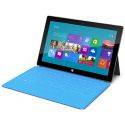Computerware Blog
The New Microsoft Tablet Has Surfaced
Microsoft has previously dabbled in hardware, of which most have been of the computer accessory variety. With the Surface, Microsoft unleashes a new aggressive campaign that takes aim at the tablet market that, not coincidentally, has been dominated by the company's biggest rival, Apple.
The Surface will be available in two models: The already released Surface for Windows RT, and the yet-to-be-released Surface Pro for Windows 8. As its name suggests, the Surface for Windows RT runs the Windows RT operating system (OS), a stripped-down version of Windows 8 that runs on the Surface for Window's RT's 1.3GHz Nvidia Tegra 3 CPU . The operating system features the new live tile-based graphic user interface that Microsoft has called "Metro". The OS is highly gesture-based; making it Microsoft's most user-friendly mobile offering yet.
The Surface is built into a molded magnesium case that Microsoft calls "Vapor Mg" (pronounced Vapor Mag). The Vapor Mg case is molded to .65 mm, which is thinner than your average credit card. The Surface's strong, lightweight design is 9.3mm thick and weighs-in at around 1.5 lbs. It comes equipped with a "kickstand" which is made from the same VaporMg casing as the chassis. The Surface also features a USB 2.0 port, a mini HDMI slot, a mini SD slot, and a 3.5 mm headphone jack.
The Surface's display is a generous 1366 x 768 resolution, 10.6" touchscreen with a 16:9 aspect ratio. This allows users to watch media in its intended dimensions and getting rid of the annoying black bars that accompany media on other tablets. The Surface also comes equipped with front and rear 720p HD cameras
Accessories for the Surface include the Type and Touch covers. The covers not only protect the device when closed, they offer typing options. The 6mm-thick type cover features a tactile keyboard, while the Touch cover, at 3.25mm thick, uses a pressure-sensitive mat that's made out of the same material as the cover. Each has a built-in multitouch touchpad. The covers are quickly interchangeable and are connected to the Surface by a magnetic connector on the bottom the device.
Like other tablets, Surface runs apps. Currently the Windows application ecosystem is extremely limited, but as was the case for the iPad when it premiered. Microsoft says the apps are on their way. The Surface for Windows RT has a "desktop" mode, which users of Windows 7 will recognize, but the only programs that users are able to run out of it are Office Suite staples such as Word, Excell, PowerPoint, and OneNote that comes as part of the with Microsoft Office Home and Student 2013 RT Preview; as well as Internet Explorer 10.
The Surface for Windows RT is available in 32 and 64-gigabyte versions. The 32GB version costs $499 on it's own and $599 when bundled with a black touch cover. The 64GB version costs $699 with a black touch cover included. The touch cover, if you were to buy it separately, comes in black, white, magenta, cyan or red and costs $119.99. The type cover is $10 more at $129.99 and comes only in black.
With tablets quickly becoming the portable PC of choice, Microsoft looks to join Apple and Google (Android) as a major player in the tablet market. Windows RT and Windows 8 will be featured on other manufacturer's tablets as well, but the Surface might just be a sign of big things to come from Microsoft.


Comments